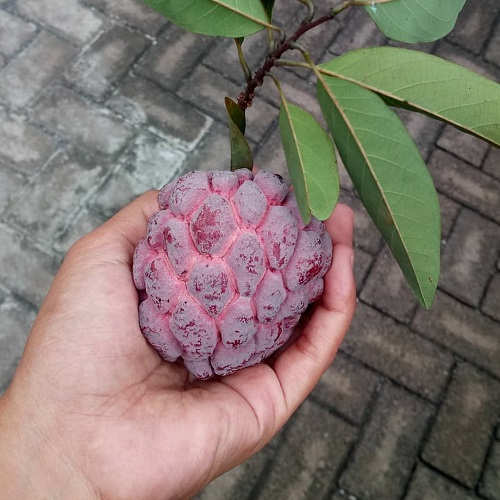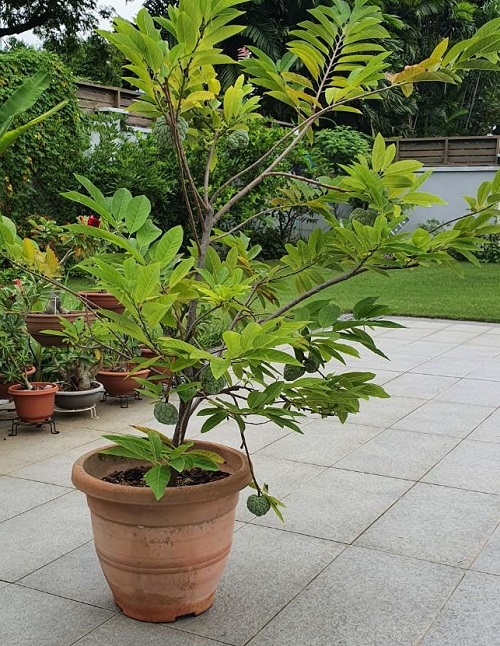Red Custard Apple Tree offers delicious fruits that you can eat fresh or use in a variety of ways! Here’s how to grow it easily at home!
If you want to make your desserts, smoothies, and fruit salads tastier, then grow Red Custard Apple for a delightful tropical treat!
Learn How to Grow Quince Fruit in a Pot here
Red Custard Apple Tree Information
The botanical name for Red Custard Apple is Annona reticulata. It belongs to the Annonaceae family, which includes several other tropical fruit trees.
Red Custard Apple is native to the tropical regions of the Americas, particularly Central America and the Caribbean. It has been cultivated and naturalized in various other tropical and subtropical regions around the world, including Southeast Asia and parts of Africa.
The fruit of the Red Custard Apple is typically heart-shaped or round, giving rise to its common name, “Bullock’s Heart.” The skin is thin and reticulated, with a reddish-brown or reddish-yellow hue when ripe. Inside, the flesh is creamy and white to pale yellow, with a sweet and custard-like flavor. The fruit contains several black, shiny seeds that are generally inedible.
The Red Custard Apple tree is a deciduous tree that can grow up to 15 to 35 feet tall. It has large, glossy green leaves and may produce fragrant flowers. The tree prefers a tropical or subtropical climate, well-draining soil, and requires moderate watering.
Red Custard Apple is primarily consumed fresh, and the sweet, creamy flesh can be scooped out with a spoon. It can also be used in desserts, smoothies, and fruit salads. The unique flavor and texture make it a delightful tropical treat.
Check out Different Types of Pink Fruits to Grow in Garden here
Propagating Red Custard Apple Tree
Methods to propagate Red Custard Apple:
- Seed Propagation
- Grafting
- Air Layering
- Cuttings
Seed propagation is the easiest and most common method to propagate Red Custard Apple. Here’s how you can do it:
- Obtain seeds from a ripe, healthy Red Custard Apple fruit. Choose fruit from a tree known to produce good-quality fruit.
- Clean the seeds thoroughly to remove any fruit pulp, as this can lead to fungal growth.
- Soak the seeds in water for a day to help soften the seed coat.
- Prepare a planting container with a well-draining soil mix rich in organic matter.
- Plant the seeds about an inch deep in the soil.
- Water thoroughly, keeping the soil moist but not soggy.
- Place the container in a warm, well-lit area, avoiding direct sunlight.
- Germination usually takes a few weeks, depending on the freshness of the seeds and the environmental conditions.
Pro Tip: It will be a great idea to get a well grafted tree from a garden centre. Grafted trees tend to bear fruit earlier than seed-grown trees. You can select a specific variety that’s proven to bear fruit.
Check Best Fruit Trees to Grow in Cold Climates in Pots here
Best Pot Size for Red Custard Apple Tree
Start with a pot that is around 8-10 inches in diameter and depth. This will give the young plant enough space to establish its roots.
As the tree grows, you’ll need to increase the pot size gradually. A pot that is about 12-16 inches in diameter and depth should work well for the next 3-4 years.
Check Fruits that Stink and Smell here
Requirements for Growing Red Custard Apple Tree
Sunlight
The Red Custard Apple Tree flourishes in full light, necessitating at least 6-7 hours of direct sun exposure daily for optimal growth and fruiting.
For optimal growth, position the tree facing south or southeast to harness ample sunlight throughout the day.
Soil
Use well-draining soil and enhance it with components like compost, perlite or vermiculite, and coarse sand. A balanced soil mixture can consist of about 60-70% garden soil, 20-30% compost, and 10-20% perlite/vermiculite and coarse sand.
Maintain a pH level between 6.5 to 7.5, slightly acidic to neutral, for proper nutrient absorption.
Water
Before watering, always check the soil moisture. Insert your finger about an inch into the soil. If it feels dry, it’s time to water. If it feels damp, wait a day or two before checking again.
Aim the water at the base of the plant, near the soil line, avoiding the foliage, as wet leaves can lead to fungal diseases.
Temperature and Humidity
Red Custard Apple Tree thrives in warm climates between 68°F to 90°F (20°C to 34°C) and is sensitive to cold below 50°F (10°C).
The tree prefers moderate humidity, with slightly higher levels during growth and flowering. Good airflow is important, and protection from frost and strong winds is recommended.
Check Fruits That Grow on Vines here
Red Custard Apple Tree Care

Fertilizer
Apply water-soluble fertilizer for fruit trees or a 2-8-8 (NPK) formula every 6 to 8 weeks, when the Red Custard Apple Tree is actively growing (Spring) after diluting it to 1/2 of its recommended strength.
Do not feed the plant in winters and after harvesting.
Pruning
Pruning the Red Custard Apple Tree is essential for its health and shape. Techniques include removing dead or diseased branches, thinning crowded growth, and shaping the tree’s structure.
Best done during winter dormancy – avoid heavy pruning during flowering and fruiting.
Pests and Diseases
The Red Custard Apple Tree is susceptible to pests like moths, aphids, mealy bugs, and scales. Insects infest the fruits, causing damage.
An effective method is shielding the Custard apple fruits with covers like plastic bags, paper, or polyethylene during early development. The bags should envelop the fruits, remain open at the base, and have micro-perforations for gas and water release to prevent excess moisture and fruit rot.
The Red Custard apple tree also faces prevalent diseases like anthracnose and leaf spot, which worsen during rainy periods and stable, high temperatures.
Check out Dwarf Fruit Trees Under 6 Feet here
Harvesting Red Custard Apple Tree
Generally, a Red Custard Apple Tree grown from seeds may take anywhere from 3 to 5 years to bear fruit, depending on the growing conditions and care provided.
When to Harvest
- Check the Color: The skin of the Red Custard Apple will change from green to reddish-brown or reddish-yellow when it’s ripe.
- Feel the Texture: Gently press the fruit; a ripe Red Custard Apple will yield slightly to pressure. It should feel soft but not mushy.
- Watch for Splitting: Sometimes, the fruit may crack open slightly at the blossom end when it’s ready to be picked.
- Monitor the Tree: Keep an eye on the tree regularly, as the fruit may ripen quickly, especially in warm weather.
How to Harvest
- Use Clean, Sharp Scissors or Pruners: This helps to make a clean cut without damaging the tree or fruit.
- Cut the Stem: Clip the stem about an inch from the fruit to avoid tearing the skin.
- Handle with Care: Red Custard Apple can be delicate, so handle it gently to prevent bruising.
- Immediate Consumption or Storage: If you’re not consuming the fruit immediately, store it at room temperature until fully ripe, then refrigerate it if necessary.
FAQs
1. Can Red Custard Apple Trees Be Grown Indoors or in Containers?
Absolutely! While these trees prefer tropical climates, they adapt well to containers with proper care, allowing you to enjoy their tropical beauty even in non-tropical regions.
2. Companion Plants That Benefit Red Custard Apple Tree Growth
Certainly, marigolds and basil can be planted near Red Custard Apple trees to ward off pests and attract beneficial insects, creating a healthier ecosystem for your tree to thrive in.
Secret Master Gardener’s Tips to Get the Most Colorful and Vibrant Flowers
3. How to Encourage Flower and Fruit Production in Red Custard Apple Trees?
Boost flower and fruit yield by utilizing balanced fertilizers, ensuring adequate sunlight, practicing regular pruning, and maintaining optimal humidity levels to create favorable conditions for the tree’s reproductive success.
4. Medicinal Uses of Red Custard Apple
Red Custard Apple is believed to possess anti-inflammatory and antioxidant properties in traditional medicine. However, it’s essential to consult a healthcare professional before considering any medicinal applications.




